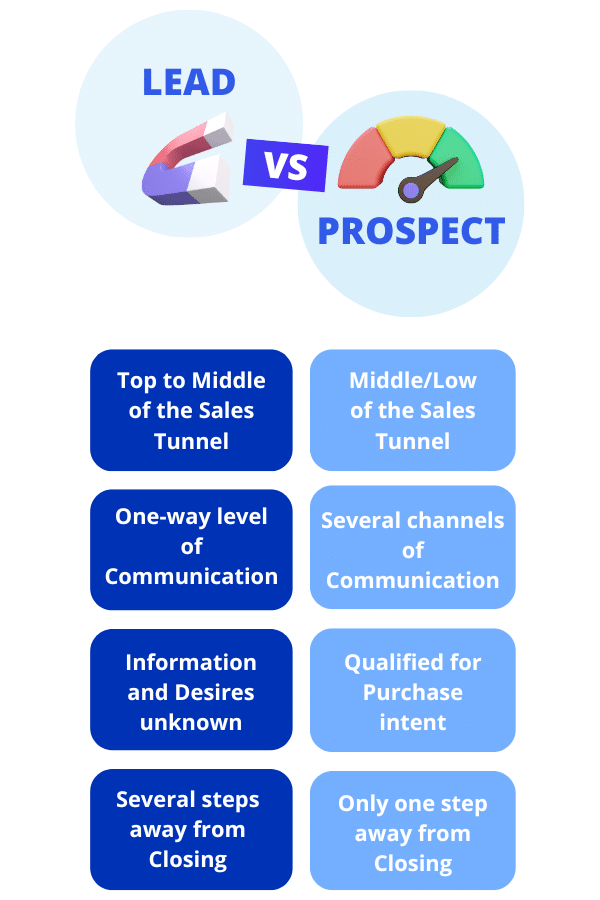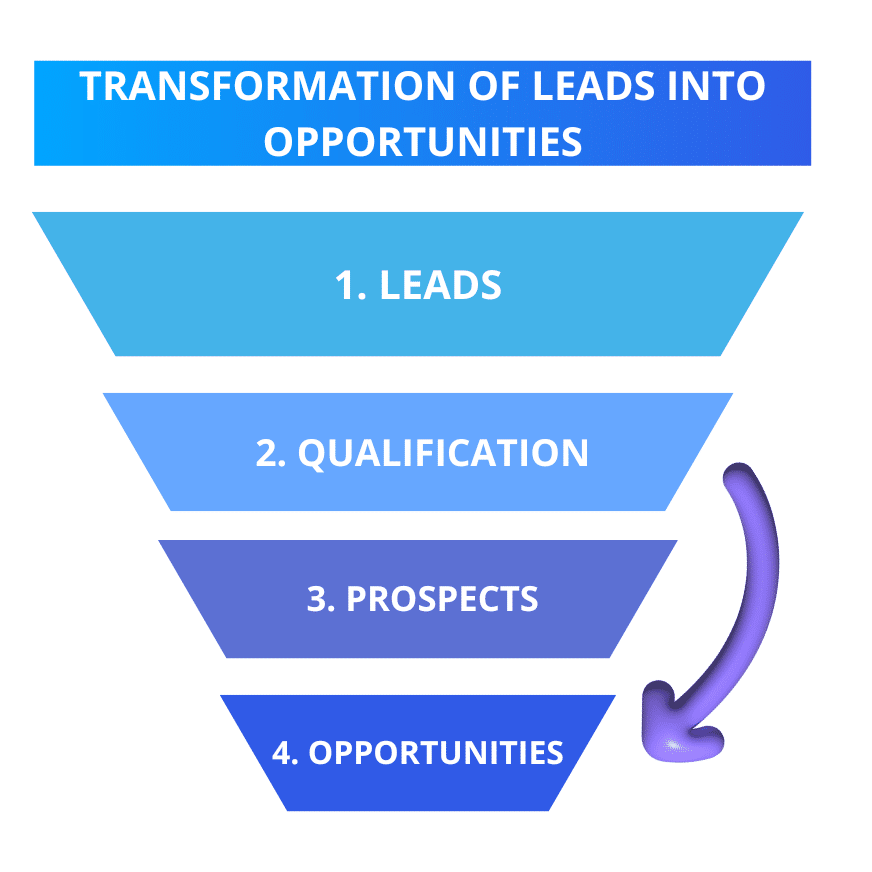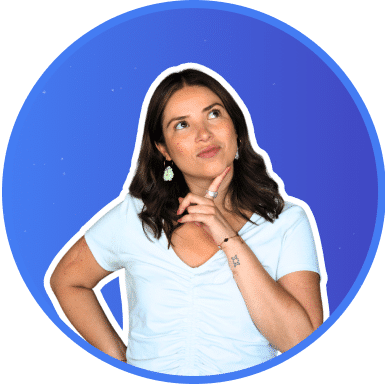Do you want to grow your business and attract new customers? 🎯 Before you start prospecting, take the time to understand the difference between lead vs prospect.
To read this article will help you develop the best prospecting strategy and adjust your pitch. Learn how! 🗣️
What is a Lead?
Leads are often used in B2B marketing contexts as a means of acquiring new customers. 🤑 It’s a contact who has shown an interest in your company/team or what you have to offer.
This could be a visitor who has filled in an information sheet in-store or at a trade show, or by replying to an email after requesting a quote or information. 📧
This is the very first contact you’ve had, so you don’t have enough information to define this contact’s needs. 🤔

What is a Prospect?
Prospects can be defined as qualified leads. 🤓 This qualification is usually carried out by a salesperson team.
After the data analysis, he can determine whether this prospect corresponds to the company’s target. 🧲 If this is the case, he’ll be able to offer the product or service that best meets his expectations and, as a result, he’ll choose your business.
One of the main tasks of salespeople in B2B activities is to convert leads into prospects. In other words, they “qualify” the leads generated thanks to the various marketing efforts. 💪
What is a Sales Opportunity?
Sales opportunities represent qualified leads that have been thoroughly evaluated and are likely to convert into customers. 🤩
This is a prospect who has shown significant interest in your product or service, has a clear need that fits your offering, and has the authority and resources to make a purchasing decision. 💸 Identifying sales opportunities requires understanding your prospect’s buying signals, timing, and budget.
This is a critical stage in the sales process that marks the transition from latent interest to actionable intent, and targeted, personalized sales efforts can effectively lead to a successful deal. 🙌
What is the difference between Lead vs Prospect vs Sales Opportunity?
Now that you know what lead, prospect, and sales opportunity are, let’s see what are the main differences. 🔎 In fact, it all depends on the degree of maturity of the contact.
The customer journey begins with a suspect. 👉 If he’s just a visitor to your website, he’s hardly considered a lead. In fact, at this stage, you don’t have the information you need to contact him and see if the solution meets his needs.
Qualified prospects and leads, on the other hand, show that they have specific needs and that your company can meet them. 👂 Salespeople can conduct an investigation and determine precisely whether this target or “buyer persona” meets the defined business objectives.
On the other hand, a sales opportunity is a potential sales transaction with a prospective customer who has demonstrated a clear interest and ability to purchase a company’s products or services. 💶
So, what’s the difference between lead vs prospect vs sales opportunity? 🧐 Leads learn about your product and are only at the first stage of information gathering.
Whereas prospects or “qualified leads” will take a more proactive approach. Salespeople need to make sure their needs match your company’s services.
An “opportunity” or customer is when they’re at the final stage of the sales process. 👏 A customer is someone who is truly convinced to make a purchase.
It’s important to differentiate between leads and prospects so as not to waste time with people who are only curious about your solution, but don’t have a problem to solve thanks to your product or service. 🤷
Here’s a lead vs. prospect infographic, to illustrate these points: ⏬

How do you measure the maturity level of your Leads and Prospects?
To measure the maturity of your contacts, you can implement a “lead scoring” commercial strategy, which we will explain immediately afterwards. 🌟
Measuring the maturity level of your leads and prospects is crucial to optimizing your sales strategy. 🤑 Start by defining specific criteria based on behavior and engagement, such as the number of interactions with your site, signing up for newsletters email or participating in webinars. ☄️
Use lead scoring CRM tools to award points according to these criteria, allowing you to classify prospects from “hot” to “cold”. 🤒
The most mature leads are those who show active and regular interest, indicating that they are closer to making a purchasing decision. 🧠 Adapting your communications plan based on this level of maturity can greatly improve the effectiveness of your sales efforts.
What is Lead Scoring?
Indeed, to optimize conversion rates (converting leads into customers), sales teams can choose how to score leads, i.e., do lead scoring. ⭐
This allows you to assign a score from 0 to 100, for example. If you assign a score of 90, prospects are more likely to request your services. 👉 However, if the score is 10, there’s little chance of conversion.
In this example, we’ll qualify the lead from 1 to 4 to determine whether it’s a warm lead 🔥or a cold prospect: ❄️

To be as precise as possible, you need to define internal criteria such as: 👇
- The contact’s function: if you speak directly to the decision-maker during exchanges, it will help you to make a sale quickly.
- Budget allocated to this type of project: if you’re offered a much lower price than the one you asked for, you know you’re less likely to turn them into a customer.
- Customer acquisition channels: depending on the sector, certain channels are more relevant than others, etc.
Companies that use lead scoring for the generation of contacts throughout the buying process are more likely to get new customers. 🚀
How to turn a Lead into a Prospect?
Turning prospects into customers is an important process that requires a clearly defined strategy. 🎯 Here are the steps to follow:
Step 1: Leads – It all starts with identifying prospects, which are people or companies that have expressed interest in your product or service. At this stage, the information isn’t specific enough. 🤨
Step 2: Qualification – Evaluating potential customers who can become real sales opportunities is the key step in this process. 🗝️ This is done by analyzing their behavior, needs, and purchasing capabilities. 💲
Stage 3: Prospects – Once qualified, the lead becomes a prospect. They are recognized as having potentially stronger interests and needs, that your product or service can satisfy. 😉 Prospects are more engaged and demand a more targeted approach.
Stage 4: Opportunity or Customer – Transforming prospects into opportunities is achieved through personalized interactions and a clear value proposition that demonstrates how your solution specifically meets a need. ⚡
This process from lead generation to sales opportunity (customer) requires effective communication and a thorough understanding of the prospect’s needs at every stage. 🕵️
Check out this graphic to better understand how contacts move from leads to qualified prospects to opportunities: 👇

Characteristic of a Sales Opportunity
Furthermore, here are some sales opportunity characteristics that can be important in converting potential leads into actual sales: ⏬
- First, the pain point is essential. This refers to a specific problem your prospect is facing that your product or service can solve. ✅ The problem needs to be serious enough for the prospect to actively seek a solution.
- Second, stakeholder interests are crucial. 🤝 This isn’t just a moment of curiosity; it’s a real commitment to the brand, demonstrated through actions such as contacting the brand for more information, responding to communications, or attending a demonstration.
- Finally, a good fit is fundamental. 🧩 This means that your prospect’s needs are aligned with the features and benefits of your product or service.
Additionally, in terms of the ideal prospect, it must have the budget, authority, and desire to buy. 🥰 Taken together, these characteristics not only indicate that a sale is likely to close, but also ensure a mutually beneficial relationship between seller and buyer.
Conclusion: Leads vs Prospects
In conclusion, knowing the difference between a prospect and a potential customer is fundamental to an effective sales and marketing strategy. 👌
A lead is a potential customer who has expressed an initial interest in your product or service, while a prospect is a qualified lead who is considered to have a high purchasing potential. 📈
Understanding this difference enables companies to tailor their marketing and communication efforts to effectively guide each group through the sales funnel.
By implementing targeted strategies to convert leads into prospects and, ultimately, find customers, companies can optimize resources, improve conversion rates and increase sales. 💰
The most important thing is to apply precise segmentation and scoring techniques, as well as developing an in-depth understanding of the needs and behaviors of each category to propose relevant, personalized offers.
FAQ : Prospect vs Lead
What’s the difference between a Prospect and a Customer?
In the world of sales and marketing, the terms “Prospect” and “Customer” designate two different stages in the process of acquiring and retaining a customer. 🥰
A lead is a person or business who has expressed interest in a company’s product or service, but has not yet made a purchase. 🛒 On the other hand, a customer is an individual or a company who has decided to make a purchase.
The transition from prospect to customer is a critical moment for a company, as it involves a confirmed customer relationship. 🤝 Although a prospect represents a potential sales opportunity, the customer validates this opportunity through their purchase, paving the way for loyalty and repeat purchases.
What is Lead Nurturing?
In marketing, the principle of “lead nurturing” is to maintain a relationship 💗 with potential customers.
This means that you will accompany your prospect from the moment they start to get to know you until the moment they buy from you, and become brand ambassadors. You will “feed” it throughout your conversion funnel. 🍝
In short, lead nurturing is a marketing strategy aimed at developing long-term, personalized relationships with prospects throughout their buying journey. 🏃
It involves providing high-quality content that convinces them to buy. For example, share content like a white paper or blog post related to their problem. 💡 This allows you to demonstrate your expertise to prospects and show them how your solution meets their needs.
Be ready! Now you know all about lead vs prospect. 🥊













